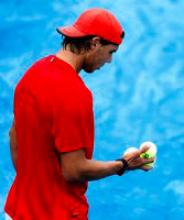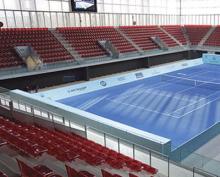Don't miss any stories → Follow Tennis View
FollowA New Blue Hue - A clay court contrasting not only in color, but tradition.
 Madrid clay was red, now it is blue. It’s the first time in history that a tournament originally designated as red clay surface switched colors.
Madrid clay was red, now it is blue. It’s the first time in history that a tournament originally designated as red clay surface switched colors.The idea behind the new court color belongs to Mutua Madrid Open owner Ion Tiriac, who had dreamed of this change for years. Tiriac believes the color blue benefits the spectator, those who attend the tournament and the fans that watch on television. The yellow tennis ball that has an extraordinary contrast against a blue background, makes tracking the ball easier and shows ball marks more accurately. In addition, players see the ball better too.
With change of this magnitude, debate among players is expected. Some believe the switch in shade represents innovation.
“It’s a real fashion statement; I wish I’d thought of it myself,” says Venus Williams.
Serena prefers blue over red because “you don’t get as dirty, which I love.”
Jo-Wilfried Tsonga says, “If it’s faster, it’s better for me. I think it’s worthwhile trying.”
World No. 1’s Djokovic and Azarenka are not jumping on the blue clay bandwagon just yet, and, in fact, were upset that Țiriac, a former tennis player of the 1970s, was able to change the tone without first consulting the players. Tiriac insists that both the ATP and WTA approved the new tint.
“If you don’t have, especially, the top players testing the court and agreeing for this change, that should mean something. The ATP should have done a better job in representing the players’ rights,” said Djokovic. “I hope that we don’t have injuries and that we can have a decent week of tennis here.”
“Nobody really asked the players if they want to do it, so what’s the point in talking about it?” said Azarenka, who added, “…the ball bounces differently on blue clay.”
Rafael Nadal says the change in color compromises the integrity of the sport and alters tradition. “The history of the clay court season was on red, it wasn’t on blue. This tournament is big because the history is there. Best players of history played in this court. My opinion is it is a mistake.” Nadal threatens to boycott the event next year if they don’t revert to red.
 Economics and marketing basics would suggest that the decision to convert the color was made out of financial necessity. Similar to a restaurant changing its menu or a store remodeling to offer customers a contemporary environment, tournaments work to offer spectators and sponsors new, exciting innovations with hopes of not only surviving but thriving.
Economics and marketing basics would suggest that the decision to convert the color was made out of financial necessity. Similar to a restaurant changing its menu or a store remodeling to offer customers a contemporary environment, tournaments work to offer spectators and sponsors new, exciting innovations with hopes of not only surviving but thriving.While Tiriac says the Mutua Madrid Open is attempting to develop its own personality and is trying to reinforce its identity, tournament director Manolo Santana says the competition in gaining audiences is “ferocious” and that tennis must evolve and protect its screen quota. Their goal is to balance business with tennisphilosophy.
“It [blue] will be the new house brand, the new seal of identity. From this point onwards, the whole world will know that the blue clay court is exclusive toMadrid; it is our Denomination of Origin.”
Following the initial shock of the blue clay, Tiriac and Manolo expect the emotional dust to settle and player feedback to turn from negative to positive – or at least neutral like Tomas Berdych who shrugs, “Red, green or blue. Who cares?”
Tints, Tones and Shades
How is BLUE CLAY Produced?
To best understand how blue clay is produced, it is helpful to understand the methods used to produce the original red clay surface. Madrid Open authorities say, in essence, the selected brick must be grinded to a size of 1 to 1.5mm.
Crushed brick is produced in three steps:
- The clay is mixed with water in order to obtain a block.
- The block then needs to be heated to a temperature of between 950 and 1020 degrees.
- The final step is grinding and sifting of the brick until an adequate grain size is obtained.
The procedure for the blue clay can be described as follows:
- White clay, obtained by extracting the iron oxide from the substance, is amassed.
- The obtained block then needs to be heated to a temperature of between 900 to 950 degrees.
- The final stage is the grinding, loosening and sifting of the brick that is obtained with the precise grain size measurement.
The subsequent dying process is carried out in two ways:
The mixed white clay is treated with dye before steps 2 and 3 are completed to give the clay its blue color.
Before arriving to the third step, the white clay is immersed in dye for a period of 24 hours before going through a drying process. The dye used in both cases is water-based.
Once the blue clay is obtained, the process of preparing the court begins. On the base of what will be the court, two types of blue clay are spread. Incidentally, to prevent white patches appearing when the players slide on the surface, the first layer of clay must be stained.
The grain size of this first layer is much finer, and it is this that will set the base. Once this process has been finalized, the second layer of blue clay – which is the one visible and the one on which the players slide – is put into place. In the entire process the amount of sand used per court is approximately 3.5 tons.
It’s important to recognize that the original red bricks cannot be directly dyed. The desired color would never be achieved because the base of the red brick would give off a different effect. For that reason, the iron oxide must be removed at the start of the process. Also, interestingly, if one hand is placed in a bag of red clay and another in a bag containing blue clay, the hand in red would leave a stronger stain because the contrast on the skin is less.
This article is from the July / August 2012 issue |
|

|
SOLD OUT Subscribe now and you'll never miss an issue!
|










